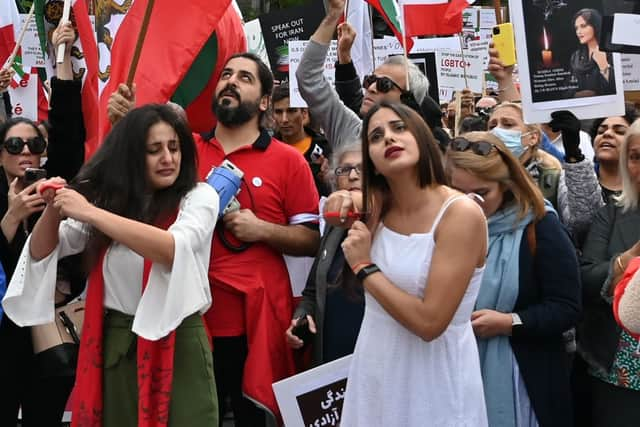Mahsa Amini is a name being kept alive at the Qatar World Cup thanks to protesters at the Iran versus England game
People in this article


Mahsa Amini is a name we should not forget. Her name is being kept alive at the World Cup in Qatar as continuing anger over the Iranian regime forges a new battleground. The face of Mahsa could be seen on hundreds of placards outside the stadium hosting the Iran versus England game on Monday 21 November 2022.
Mahsa lost her life at the age of 22, just a few days away from her 23rd birthday. She lost her life in the most brutal way. She was arrested on 13 September 2022 as she visited Tehran to see her brother, who was with her when the Guidance Patrol, also known as the Iranian morality police, took Mahsa away.
Advertisement
Hide AdAdvertisement
Hide AdHer crime? Mahsa was allegedly breaking the country’s strict Islamic dress code. Wearing a headscarf, which most women do in Iran, is not enough. The headscarf must be fully covering the hair, according to law enforcement in the country. Mahsa wore a headscarf, but not to the pleasing of the men who saw her that day and who wielded the power of life and death over her fate.
Her brother was told she would be taken to the detention center to undergo a ‘briefing class’ and released an hour later. Her brother did not see Mahsa alive again.
He was informed his sister had a heart attack and a brain seizure at the police station to which she had been taken. Two hours after her arrest, she was taken to Kasra Hospital. According to eyewitnesses in the van with Mahsa, she was tortured and insulted in the van. She died of her injuries two days later.


Images of her grieving family, inconsolable outside the hospital were seen across Iran. A daughter, sister, granddaughter, niece, friend, gone from their world.
Advertisement
Hide AdAdvertisement
Hide AdMahsa, who was known by her family by her Kurdish name of Jina, had been accepted to university to study law and was due to take her place this autumn. Her life would have been one of making positive changes through a career in law, and her death has ignited a tsunami of feelings amongst many people in Iran on the topic of abuses in law enforcement.
Protesters have taken to the streets across 31 Iranian provinces and other countries, including Turkey, Lebanon, Canada and France, have also had huge protests, in defiance of the Islamic republic’s treatment of women. Men have also joined the protests in Iran, although the demographic has been largely younger women. Protests outside of Iran have seen a more mixed gender and age range of participants.


The protesters have made powerful gestures of publicly cutting their hair and removing and burning their veils. All these actions are at incredible personal risk. Iranian state TV have claimed less than 50 demonstrators have been murdered by police, however, this figure is much higher. At least 200 have been killed, with more than 58 children dead as part of censoring by the Iranian regime.
This is a lingering issue for Iran. They've seen more than 20 years of the women's movement having moments of protests, since the very inception of the Islamic Republic. Women have always been key to challenging the regime and the rise of social media has allowed new outlets for dissenting voices.
Advertisement
Hide AdAdvertisement
Hide AdThousands have been rallying daily across the country. Mahsa’s legacy, a woman who avoided politics in life, could be seismic in Iranian culture. Amini has been described as having been a ‘shy, reserved resident of her hometown’ in Saqqez who avoided politics, was never politically active as a teenager, and was not an activist. Yet, she has brought out the activism in people, many of whom have not protested before.
In October, a 23-year-old TikTok star named Hadis Najafi was among those shot dead in protest over Mahsa’s murder. Mobile phone footage from near Tehran’s renowned Sharif University shows security forces using tear gas and people trying to escape gunfire.
Iran’s reigning elites have no cause to see the status quo of subjugation on women change anytime soon. When the current model fits the agenda for the men in charge, why make any alterations? Only the women, children and men with no sway see the danger of this particular form of silencing. Wiping out the voices of a younger generation who are exposing the inequalities facing anyone in Iran who does not meet a strict version of ‘moral behaviour’. Where does the brutality stop?
And so, ironically, the murders continue by the morality police. The bravery of the protesters becomes stronger. They risk their lives to ensure a future where freedom could be a realistic outcome.


Advertisement
Hide AdAdvertisement
Hide AdAnd Qatar, a country receiving it’s own share of criticism for human rights abuses, has become a media hotspot to shine the light on Iran’s merciless government.
“In my heart, I don’t want them to win,” said Mokhtar, 59, speaking to The Guardian in Qatar ahead of the Iran versus England game. "The propaganda value of defeating Iran’s former colonial master, England, would simply be too irresistible for the country’s embattled rulers," he said.
As Iran’s national anthem was played before kick-off, fans sounded their horns in defiance and loud boos echoed throughout the stadium. Iran’s squad linked arms and stared into the distance, none uttering a word as fans, some in tears, applauded their silent gesture.
Mahsa Amini is a name we should not forget. Women’s lives in Iran, and across the world, depend upon it.
